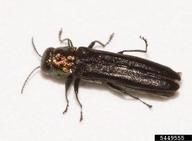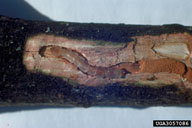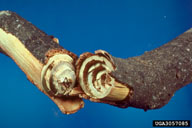Hickory spiral borer
Agrilus torquatus LeConte (Coleoptera: Buprestidae)
Orientation to pest
Hickory spiral borer, Agrilus torquatus LeConte, is a native beetle found over a wide area in the eastern United States, feeding principally on pecan (Carya illinoinensis [Wangenh.] K. Koch) and hickory (other Carya spp.). There are a group of four closely species that previously were considered subspecies of Agrilus arcuatus, but all of which have now been raised to full species status, using their former subspecies names. These include A. arcuatus torquatus, the focus of this page, which attacks hickory and pecan; A. arcuatus fulgens from hazel (Corylus); A. arcuatus corylicola - also from hazel (Corylus); and A. arcuatus arcuatus from oak (Quercus) and American beech (Fagus grandifolia Ehrh.).
Agrilus torquatus requires two growing seasons to complete its development, emerging in the spring or summer (May to July) of the third year. After emerging, adults feed on host foliage, making large irregular holes in the leaves. Eggs are deposited singly on the bark surface of terminals or lateral twigs, usually near the base of small shoots of the current season's growth and are covered with a transparent secretion that glues them in place. Larvae tunnel beneath the bark, where they fed for two growing seasons. In late autumn, they begin spiral burrows, encircling the stem until reaching the center and severing the twigs by spring. Larvae pupate in cells constructed in the pith of the stem. The most distinctive aspect of the damage of this species is the spiral track made by the larvae, which is characteristic in form and good for identification of the pest. This track is a winding concentric gallery that moves from the inner bark to the heart of the branch or stem. Branches and terminals are usually severed in late winter or spring and the portion beyond the girdle typically dies before new foliage appears in spring, making damaged terminals easy to spot. Most severed branches break and fall to the ground around the time that buds open. Attacked twigs are usually from ca 1-4 cm in diameter and 0.5 to 2.5 m long. While most damage is to twigs and small branches, when seedlings are attacked they may be killed. Extensive damage to large pecan trees reduces nut production, and gives trees a ragged appearance. Repeated attacks on young trees may make them stunted, misshapen, or crooked.
Hosts commonly attacked
The hosts of this species are pecan (C. illinoinensis) and species of hickory (Carya).
Distribution
This species has been recorded from New York, Ohio, North Carolina, and Mississippi.
Images of hickory spiral borer
| Figure 1. Adult of the closely related Agrilus arcuatus | Figure 2. Larva of hickory spiral borer, Agrilus torquatus | Figure 3. Distinctive spiraling pattern of larval galleries of hickory spiral borer |
Important biological control agents related to this pest species
Five insect parasitoids are known to attack this borer: Labena apicalis Cresson, Labena grallator (Say), Monogonogastra agrili (Ashmead), Tetrastichus rugglesi Rohwer, and Zatropis sp. near nigroaeneus (Ashmead).
Articles
- Nelson, G. H. and H. A. Hespenheide. 1998. A re-evaluation of some Agrilus Curtis species (Coleoptera: Buprestidae). Coleopterists Bulletin 52(1): 31-34.






